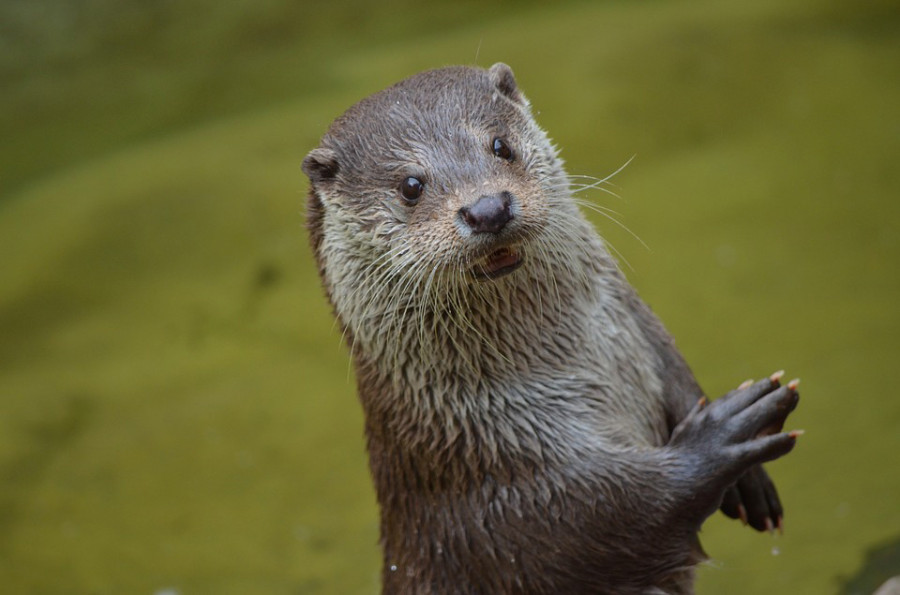Opinion
Meant for each otter
Conservation is focused on iconic species while this aquatic mammal faces extinction.
Chandramani Aryal
Nepal is considered to be at the forefront of biodiversity conservation, but our focus is directed at a few iconic species, and less famed animals are often neglected. One of them, the otter, is not getting the attention it deserves. Otters primarily eat fish, and so are considered to be indicators of freshwater ecosystems. Nepal is home to two species of otters—the Eurasian otter and the smooth-coated otter.
The Eurasian otter is found in the lakes and rivers of the mountain region while the smooth-coated otter is found in river systems of the Tarai. Brian Hodgson, who was the British Resident in Kathmandu in the 1830s and known for his studies of Himalayan flora and fauna, among other subjects, mentioned the presence of the small-clawed otter in Nepal. But this species has not been recorded in the country in modern times.
The little information available about the distribution and threats to otters has prevented us from finding out their conservation status in Nepal. But there is common agreement among conservation practitioners that their population is declining. The Eurasian otter is listed as near threatened while the smooth-coated otter is listed as endangered, a status similar to that of the Royal Bengal Tiger. Despite such reports, the government has paid little attention to its conservation.
Habitat degradation and fragmentation, the illegal pelt trade and other threats are driving otters towards extinction in the country. Among different plausible threats, illegal wildlife trade is one of the major ones. Different species of otters are heavily trafficked throughout the world, primarily due to the high number of fur per unit area of the pelt. According to a report published by the International Otter Survival Fund, at least 10 otter pelts are found for every tiger pelt recorded. The situation is worse in the case of Nepal. According to a recent report published by researchers based on the seizure data from governmental and other sources, 755 otter pelts were confiscated in Nepal between 1989 and 2017. As the report is based only on the confiscation records, there is a high probability that the species is facing a tremendous threat from the illegal trade.
In the late 1990s, otter specialist Paras Mani Acharya carried out a survey around the Begnas and Rupa lakes in Pokhara and confirmed the presence of Eurasian otters in the area. The species is believed to be extinct in these areas as of now. High human interference and the pelt trade are the reasons behind the local extinction. The smooth coated otter is believed to have met a similar fate in the Narayani River system. The species was sighted, with abundant signs of its existence being recorded, during the survey in 2008 while no signs were found in 2012 and later. The West Seti Hydropower Project site is the only location in Nepal with a confirmed presence of the Eurasian otter in Nepal. Ample evidence exists about the presence of the smooth-coated otter in Bardia National Park and its vicinity and Sukhlaphanta National Park.
Government agencies are yet to prioritise the conservation of otters in Nepal. Despite receiving little or no attention from the government, field conservationists have made a few efforts on their own. The interest in the ecology and conservation of otters is on the rise. Conservation practitioners realise the need for collaborative efforts for the conservation of otters. Despite the growing interest, many pieces of research related to otters are primarily done by using social science techniques where researchers ask the local people about the prevalence of the species in the area.
Though it has its own significance, the vernacular name often creates confusion and species are misreported, according to conservationist Hari Basnet. Locals in Rukumkot reported the presence of Pani Ooth and Pakhe Ooth, and the description they gave was similar to that of the smooth-coated otter. Later, the team found pelts of the species they had described which were identified as masked palm civet pelts. Besides civets, people also report crab-eating mongooses as otters due to their similar appearance.
Evidence of the distribution and threats are vital to devise conservation measures for otters in Nepal and elsewhere. So efforts both from the government and the private sector are essential. Locals can make a significant contribution to the conservation of the species. For this, we need to make them aware of the importance of otters and the significant role that the local people can play for their conservation. Every year, the last Wednesday of the month of May is celebrated as World Otter Day which fell on May 29 this year. Let’s hope that, following this year’s World Otter Day, we think more about this magnificent animal.
Aryal is a member of the faculty at the Department of Environmental Science, Tri-Chandra Multiple Campus.




 18.12°C Kathmandu
18.12°C Kathmandu










